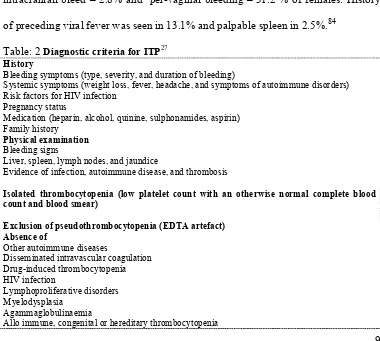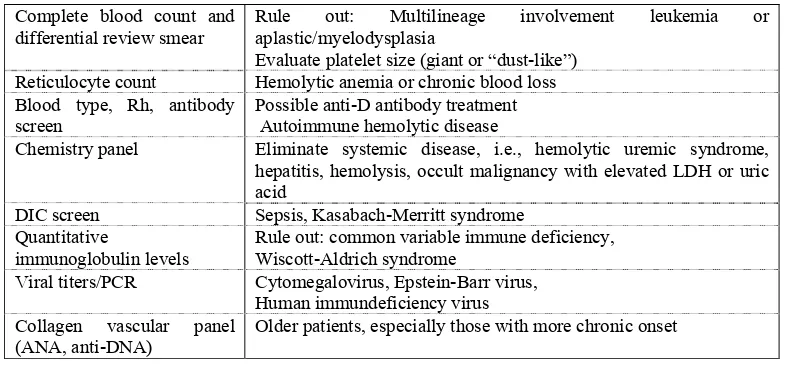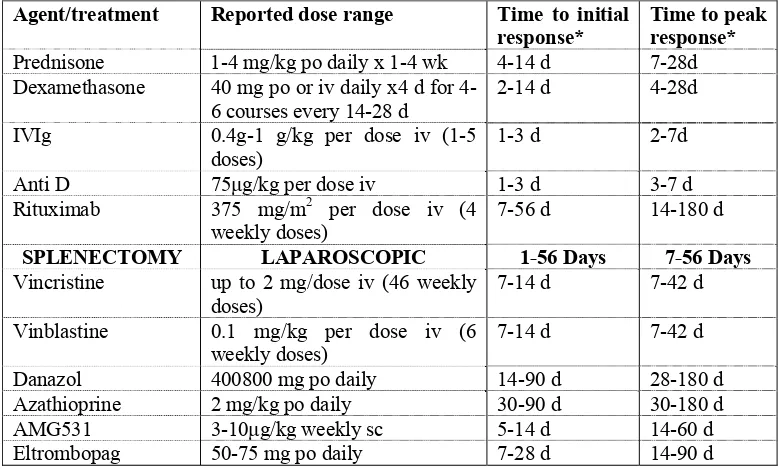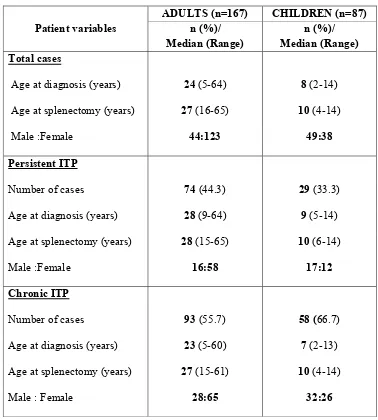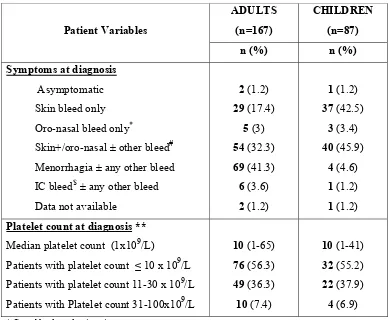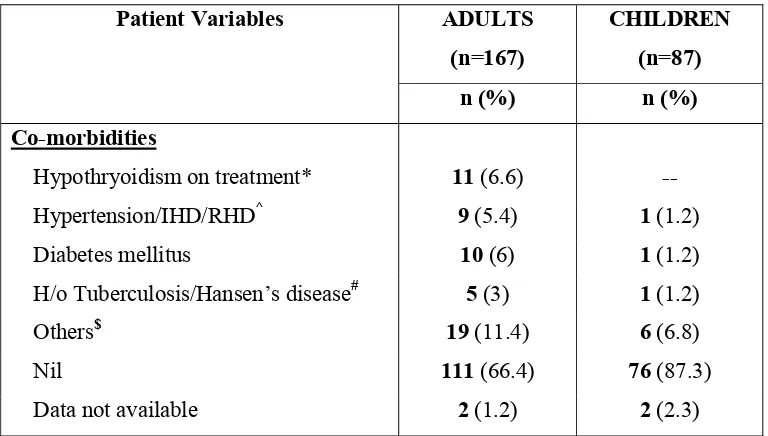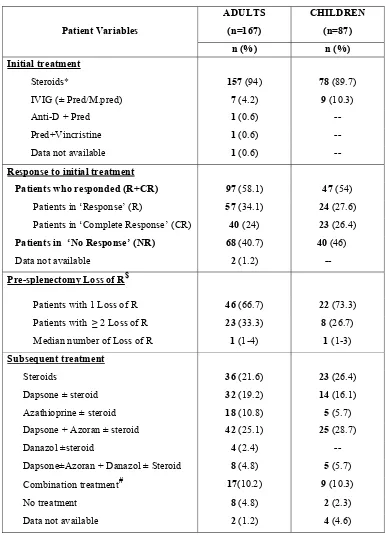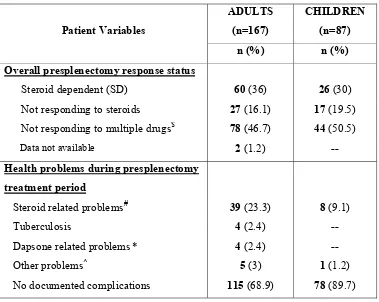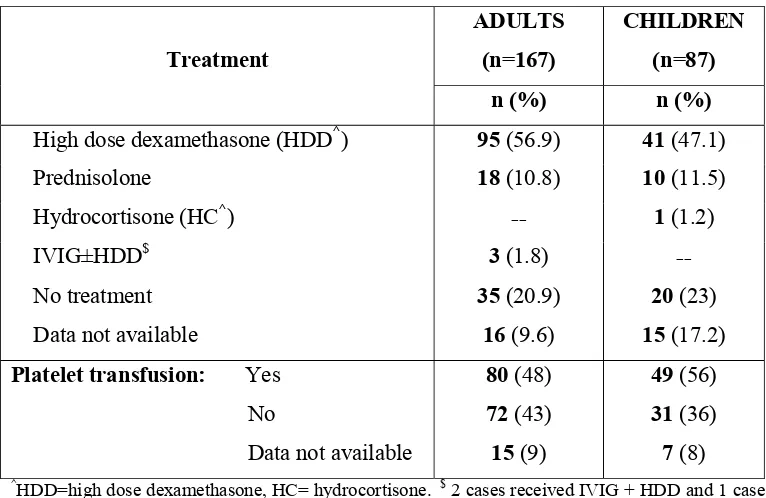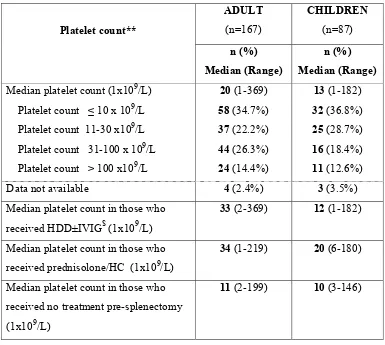Thesis submitted to the
Tamil Nadu Dr.M.G.R.Medical University,
Chennai
For the degree of
Doctorate of Medicine (DM)
In
Clinical Haematology
By:
Dr.Rayaz Ahmed, MD
For the year: August 2010
Department of Clinical Haematology
Christian Medical College, Vellore.
Splenectomy for children and adults with
persistent and chronic immune
CERTIFICATE
This is to certify that this thesis titled “Splenectomy for children and
adults with persistent and chronic immune thrombocytopenia: long
terms results”, is a bonafide work of the candidate, Dr.Rayaz Ahmed
during the period from August 2008 to August 2010 in partial fulfilment,
towards the award of degree of Doctorate of Medicine (higher specialty)
in Clinical Haematology for the examinations to be conducted by the
Dr.M.G.R Medical University in August 2010.
Dr. Alok Srivastava, MD, FRACP, FRCPA, FRCP
(Thesis Guide)
ACKNOWLEDGEMENT
(In the name of God, Most Gracious; Most Merciful)
I am heartily thankful to my guide and Professor, Dr. Alok Srivastava, whose encouragement,
guidance and support from the initial to the final level made this work possible. I take this
opportunity to express my gratitude to my teachers Dr.Mammen Chandy, Dr.Vikram Mathews
and Dr.Auro Viswabandya for their expert opinions and guidance. I am indebted to all my
colleagues and friends in Clinical Haematology for their constant support and encouragement.
Last but not least I offer my regards and blessings to all the patients and their families for their
CONTENTS
Sl. Number
Topic
Page number
1
Abstract 1
2
Introduction
2
3
Review of literature
3
4
Aims & Objectives
24
5
Patients & Methods
25
6
Results
29
7
Discussion
54
8
Conclusions 73
9
Appendix I & II
i
10 Proforma
iii
10
Bibliography
viii
1
ABSTRACT
Background: Although immune thrombocytopenia (ITP) is a common cause of
thrombocytopenia among both children and adults, information regarding
prognostic determinants of outcome of splenectomy and the management of
patients who fail to respond to splenectomy is limited.
Aims and Objectives of the study: To analyze the response to splenectomy and to
assess the response to treatment of refractory ITP post splenectomy, in children
and adults with persistent and chronic ITP in our institution.
Methodology: All patients with persistent and chronic ITP seen in the Department
of Haematology between 1995 and 2009 who underwent splenectomy and whose
data could be retrieved were analyzed.
Results: Of the 167 adults and 87 children, 82.6% of adults and 88.5% of children
were in response at 2 months post splenectomy. After a median follow up of 18.6
months (range:1-170) in adults and 12 months (range: 1-173) in children post
splenectomy, 115 (68.9%) adults and 63 (72.4%) children showed a response,
while 48 (28.7%) adults & 23 (26.4%) children were refractory to splenectomy.
The overall mortality was 6 (3.6%) in adults and 1 (1.2%) in children. Among
those who were refractory to splenectomy, subsequent drug treatment resulted in
response in additional 25 (15%) of adults and 16 (17.2%) of children. The 5 & 10
year event free survival of total cases were 75.2 ± 3.7% & 71.5 ± 4.5% in adults
and 79.1 ± 4.6% & 70 ± 7.5% in children respectively. Among adults, females and
those who had higher platelet count at splenectomy had a higher chance of
response to splenectomy. While in children, persistent phase of the disease was
associated with response. The median time to post splenectomy response was
shorter and the median peak platelet count was higher among those who showed
sustained response in both groups.
Conclusion: In this first large series form India, comprehensively analyzing
outcome of patients with ITP undergoing splenectomy, the response to treatment is
similar to those reported in the literature in both adults and children from other
population. Further analysis needs to be doneto ascertain the predictive value of
2
INTRODUCTION
Immune thrombocytopenia (ITP),12 an autoimmune disorder is a common cause of
thrombocytopenia,1 among both children and adults, characterized by the
development of auto-antibodies against platelets, a spectrum of clinical severity,
and a minor to severe reduction in platelet count (<100 x109/L). 1,12,40,54
ITP has a combined prevalence of 1–13 per 100,000 persons1,15, with an
overall female to male ratio of 2:136. Despite similar pathogenetic mechanisms,
the natural history of ITP differs between children and adults. In children, the
disorder is often self-limited with short course, whereas in adults it is associated
with a persistent and chronic course,12,20,34,39,48,54,55 a higher rate of complications,
and an inadequate response to drug therapy3.
Most ITP patients are treated initially with corticosteroids and, if no lasting
response occurs, undergo splenectomy. 1,2,15 This initial approach results in a stable
response in 60-70% of ITP patients. Even in the present era, the response rates of
splenectomy are 50-85% compared to the response rates of 15-30% when steroids
are administered. Since sustained responses after discontinuation of the drug occur
in only 25% or less, surgical therapy is preferred as it usually gives complete
response.7
For patients who fail to respond to splenectomy and for those who
experience a loss of response after splenectomy, treatment remains difficult and
undefined. However there are not many Indian data addressing these issues.2,7 The
present study is the retrospective and prospective review of the experience at our
3
REVIEW OF LITERATURE:
DEFINITIONS:
Until recently, ITP was defined as isolated thrombocytopenic purpura (platelet
count < 150 x109/L) in a patient who has no clinically apparent associated
conditions or factors that can cause thrombocytopenia, including human
immunodeficiency virus (HIV) infection, systemic lupus erythematosus,
lymphoproliferative disorders, myelodysplasia, agammaglobulinemia, therapy with
certain drugs, alloimmune thrombocytopenia, and congenital or hereditary
thrombocytopenia.1,2,30,40,65 Thrombocytopenia lasting less than 6 months was
termed as acute, and greater than 6 months as chronic.20, 30,34, 39,48,54,55
However, an International Working Group (IWG; decided during the 5th
official meeting of the European Hematology Association (EHA) Scientific
Working Group on Thrombocytopenias) held on June 7, 2007, during the 12th
EHA Congress in Vienna)12 addressed the pitfalls in the definitions and
terminologies used in ITP and has put forth the below mentioned recommendations
(Table:1).12
The term “purpura” was felt inappropriate, because bleeding symptoms are
absent or minimal in a large proportion of cases. The acronym ITP (now proposed
to stand for immune thrombocytopenia) was preserved because of its widespread
4 Table:1
Proposed definitions of disease12
Primary ITP Primary ITP is an autoimmune disorder characterized by isolated thrombocytopenia (peripheral blood platelet count <100 x109/L) in the
absence of other causes or disorders that may be associated with thrombocytopenia. The diagnosis of primary ITP remains one of exclusion; no robust clinical or laboratory parameters are currently available to establish its
diagnosis with accuracy. The main clinical problem of primary ITP is an increased risk of bleeding, although bleeding symptoms may not always be present.
Secondary ITP All forms of immune-mediated thrombocytopenia except primary ITP*
Phases of the disease Newly diagnosed ITP: within 3 months from diagnosis
Persistent ITP: between 3 to 12 months from diagnosis. Includes patients not reaching spontaneous remission or not maintaining complete response off therapy.
Chronic ITP: lasting for more than 12 months Severe ITP: Presence of bleeding symptoms at presentation sufficient to mandate treatment, or occurrence of new bleeding symptoms requiring
additional therapeutic intervention with a different platelet-enhancing agent or an increased dose
*The acronym ITP should be followed by the name of the associated disease (for thrombocytopenia after exposure to drugs, the terms “drug-induced” should be used) in parentheses: for example, “secondary ITP (lupus-associated),” “secondary ITP (HIV-associated),” and “secondary ITP (drug-induced).” For manuscript titles, abstracts, and so on, definitions such as lupus-associated ITP or HIV-associated ITP can also be used.
HISTORY:
Idiopathic thrombocytopenic purpura (ITP), also known as immune
thrombocytopenic purpura and autoimmune thrombocytopenic purpura, and most
recently as immune thrombocytopenia12 has a long history. Purpura [the Latin
derivative of the Greek word porphyra (Porfura), so-called for the purple-fish, was
recognized by the ancients, including Hippocrates and Galen, who described
purpura associated with pestilential fevers. Down the lane, Avicenna (10th century
Arab physician), Amatus Lusitanus (1580) and Lazarus de la Rivie`re ([Riverius],
France,1658) described purpura in association with fever and without fever.
Idiopathic thrombocytopenic purpura (ITP) was first described by P.G. Werlhof in
1735 as ‘Morbus Maculosus Hemorrhagicus.73,74 In 1951, works by Harrington,
and Evans et al contributed to the understanding of the ‘immune component’ of
distinctions
splenectomy
choice for I
Wintrobe et Ther criteria, and overcome th expert clini Conference, primary ITP
clinically m
definitions c
EPIDEMIO
ITP is a r
published e
retrospectiv
institute of M
presentation
mean platel
yr) in 46.5%
For
cases/100,00
prevalence
14 years. In
between a
y for ITP in
ITP until co
t al in 1951. 5
re is a lack
d terminolog
he present he
icians conve
, June 7, 2
P and its dif
meaningful
could be use
OLOGY:
relatively co
epidemiologi
ve analysis
Medical scie
n, females: m
let counts of
% and adult I
childhood
00 children
in North Am
n adults, the
cute and ch
n 1916, and
orticosteroid
5,7,73,74
of consensu
gy in primary
eterogeneity
ened a 2-da
2007) to def
fferent phase
outcomes a
ed by investi
ommon acqu
ical data fro
of 1230 pa
ences, report
male ratio o
f 34+ 18.3x
ITP in53.5%
ITP, Euro
n and a pre
merica is sli
annual inci
hronic ITP.
d it has sinc
ds were intro
us on standa
y ITP, and h
y, an Internat
ay structured
fine standar
es and criter
and respons
gational clin
uired bleed
om developi
atients of IT
ted a median
f 51.1: 48.9
x109/L at pr
%.84
pean studie
evalence of
ghtly higher
idence is aro
73 Kaznels
ce then rem
oduced in th
ardized critic
has not been
tional Worki
d meeting (t
rd terminolo
ria for the g
se. These
nical trials or
ding disorde
ing countrie
TP publish
n age of 19.6
9, acute: chr
resentation, c
es reported
4.6/100,000
r, at 7.2/100
ound 1.6/100
son perform
mained the t
he treatmen
cal definition
n critically a
ing Group of
the Vicenza
ogy and def
grading of s
consensus c
r cohort stud
er. There is
es regarding
hed from th
6 years(rang
ronic ratio o
childhood IT
an inciden
027,29,36,40. T
0,000 childre
0,000, highe
5 med the first
treatment of
t of ITP by
ns, outcome analyzed. To f recognized a Consensus finitions for everity, and criteria and dies.12
s very little
ITP.27,84 A
he All India
ge 0.9–80) at
of 595: 635,
TP (age 12
nce of 5.8
The reported
en aged 1 to
er in middle
6 age when a female preponderance is observed in contrast to the equal sex
distribution amongst cases of childhood ITP (prevalence rate ratio of 1.9 for
female to male) and in the elderly. 29,36,40 A population based estimate of the
incidence and survival of ITP in the UK reported that overall average incidence
was statistically significantly higher in women (4.4, 95% CI: 4.1–4.7) compared to
men (3.4; 95% CI: 3.1–3.7). 40 Among men, incidence was bimodal with peaks
among ages under 18 and between 75–84 years. 40 A Danish group reported an
annual incidence of adult ITP as 3.2 cases per 100,000 per year, with a median age
of 56.4 years. In 2003, Neylon et al reported a median age at diagnosis of 56 years
and noted an increased incidence in the > 60 year age group.21
ETIOLOGY AND PATHOGENESIS:
The precise mechanism underlying ITP remains largely unknown. Immune
dysregulation and the development of auto-antibodies appear to play a major role.
Auto-antibodies have been shown to cause accelerated platelet clearance.22
In vivo plasma infusion studies by Harrington et al & Shulman et al first
demonstrated that a plasma factor found in most patients who had ITP resulted in
thrombocytopenia in normal individuals. 29 Subsequent plasma infusion studies by
Shulman et al showed that the plasma factor destroyed both autologous and
homologous platelets and that the thrombocytopenia effect was dose dependent
and less pronounced in splenectomised recipients, those pretreated with
corticosteroids, or after reticulo-endothelial blockade induced red cell membrane.49
These auto-antibodies are mainly IgG, and occasionally IgM and IgA. They
are present in about 50–70% of ITP patients and they recognize one or more
platelet surface glycoproteins (GP) including GPIIb- IIIa, GPIb-IX and GPIa-IIa.
Antibody-coated platelets are cleared via Fcγ receptors of macrophages in the
light-7 chain restricted with an over-representation of VH3-30 heavy chains. They are
generated through the expansion of B cell clones under the control of T helper cells
and the cytokines they produce. Th1 cytokines, IL-2 and IFN-γ are increased with
reduced Th2 cytokines, IL-4 and IL-5, suggesting a type-1 cytokine polarization.
The antigens that initiate the autoimmune response are altered platelet proteins or
even viral or bacterial products that mimic these platelet peptides; 22 as suggested
by in vitro studies that the CD4+HLA-DR restricted T cells of ITP proliferate
when stimulated by GPIIb-IIIa tryptic peptides or recombinant fragments but not
by intact GPIIb-IIIa polypeptide. 22 ,49 Mc Millan et al showed suppression of
megakaryocyte production in vitro by ITP plasma containing anti- GPIb-IX or
anti-GPIIb- IIIa antibodies.79
Besides antibody-mediated platelet destruction, cytotoxic Tcell-mediated
lysis of autologous platelets has recently been demonstrated in vitro using
CD3+/CD8+ lymphocytes of patients with active ITP. T cells interact intricately
with B cells to cause antibody- and/or cell-mediated platelet destruction.22
Studies by several groups of investigators using indium-111 (111In)-labeled
autologous platelets showed considerable heterogeneity in platelet turnover in
chronic ITP. Although the platelet life span is often markedly decreased, in some
patients the lifespan is only mildly reduced. Overall, approximately 40% of
patients with ITP had a reduced platelet turnover.39 Increased apoptosis and
para-apoptosis in ITP patients’ bone marrow megakaryocytes were demonstrated by
ultrastructural studies done by Houwerzijl E et al, and these changes were
presumed to be caused by platelet autoantibodies in vivo (inhibiting
megakaryopoiesis and pro-platelet formation). 22
So far all the studies on ITP suggest immune system dysregulation as the
8 is generally not known. It is likely that genetic and environmental factors also have
a role.
Genetic factors: There is a weak association with HLAB8DR3 in patients with
ITP (Stanworth et al, 2002); linked to the development or clinical course of ITP in
genetically homogeneous populations, such as the Japanese (Nomura et al, 1998).
Nonetheless, immune recognition as a result of HLA may be critical in
development of autoimmunity in heterogeneous populations as well. 24
Environmental factors:
Virus-associated ITP: Childhood ITP often occurs following a viral illness;
probably initiates ITP either via molecular mimicry or B-cell stimulation. ITP is
often associated with HIV (Bettaieb et al, 1992), Hepatitis C virus (HCV) infection
(Pockros et al, 2002; Zhang et al, 2003) and EBV infection. 24
MMR vaccine: Severe thrombocytopenia has been observed in children, in their
second year of life following MMR vaccination. The exact pathogenesis is
unclear.24
Bacteria-associated ITP: H. pylori: There is strong evidence for an association
between infection with H. pylori and ITP; related to molecular mimicry. H. Pylori
strains shows geographic variations in the cytotoxin-associated gene A (CagA),
which seems to correlate with the geographic variations in the incidence of H.
Pylori associated ITP. 24
CLINICAL FEATURES:
The signs and symptoms of ITP may be generalized into two categories: dry and
wet purpura. Dry purpura (cutaneous haemorrhage) appears as bruising or
petechiae. In contrast, wet purpura is associated with bleeding of the mucous
membranes including those of the gastrointestinal tract, mouth, nose and eyes. ITP
9 onset of petechiae or purpura approximately 2–3 weeks after viral infection or
immunization. Boys and girls are affected equally and the peak of onset is
normally around 5 yrs of age. In over 70% of cases, it resolves within 6 months.
On the other hand, ITP in adults is usually persistent and chronic12 and has
a subtle onset, with no prodromal illness. Some patients with ITP are
asymptomatic or have only mild bruising while others with platelet counts below
30 x109 ⁄L are thought to be at a high risk of serious bleeding events. Indeed, the
most frequent cause of death in association with ITP is intracranial bleeding, with
an estimated 5% rate of fatal haemorrhage in adults.22,26
Physical examination usually reveals no abnormal signs, and specifically
no splenomegaly. A study from the All India Institute of Medical Sciences, New
Delhi, reported the incidence of presenting featuresas follows: skin bleed – 91.1%;
mucosal bleed – 57.5%; hematuria – 7.2%; gastrointestinal bleed – 12.5% ,
intracraniall bleed – 2.8% and per-vaginal bleeding –31.2 % of females. History
[image:14.612.131.511.399.740.2]of preceding viral fever was seenin 13.1% and palpable spleen in 2.5%.84
Table: 2 Diagnostic criteria for ITP27
History
Bleeding symptoms (type, severity, and duration of bleeding)
Systemic symptoms (weight loss, fever, headache, and symptoms of autoimmune disorders) Risk factors for HIV infection
Pregnancy status
Medication (heparin, alcohol, quinine, sulphonamides, aspirin) Family history
Physical examination
Bleeding signs
Liver, spleen, lymph nodes, and jaundice
Evidence of infection, autoimmune disease, and thrombosis
Isolated thrombocytopenia (low platelet count with an otherwise normal complete blood count and blood smear)
Exclusion of pseudothrombocytopenia (EDTA artefact) Absence of
Other autoimmune diseases
Disseminated intravascular coagulation Drug-induced thrombocytopenia HIV infection
Lymphoproliferative disorders Myelodysplasia
Agammaglobulinaemia
10 Clinical history and physical examination (Table:2) should be directed
specifically to exclude thrombocytopenia secondary to diseases such as systemic
lupus erythematosus, antiphospholipid syndrome, immunodeficiency states,
lymphoproliferative disorders, infection with human immunodeficiency virus,
hepatitis C and H. pylori, as well as acquired thrombocytopenic disorders (e.g.,
bone marrow disorders and liver disease).
DIAGNOSIS:
ITP remains a diagnosis made after exclusion of other causes of thrombocytopenia.
Laboratory studies (Table 3, & 4) and history are the mainstay of diagnosis.20 It is
usually not necessary to perform a bone marrow aspirate with isolated
thrombocytopenia if a thorough physical examination and review of the blood
smear is performed. However, bone marrow examination is recommended in the
following situations; more than one cell lineage is decreased and the patient has
splenomegaly or adenopathy, patients scheduled for splenectomy, adults with
atypical features at diagnosis or in those >60 years, and prior to administration of
medications such as steroids, which might confound the diagnosis of leukemia,
delay therapy, or trigger an unrecognized tumor lysis syndrome. 20,21,22,27,70
Antiplatelet autoantibody testing has flourished over the past 20 years, but
it is rarely used to make the diagnosis of acute ITP in children as the other forms of
thrombocytopenia, can generally be readily distinguished without this assay.
Assays used to identify target antigens on the platelet surface have been used to in
clinical research along with measurement of platelet bound autoantibody isotype
using flow cytometry to determine whether certain antibodies are more likely to
predict a more severe or chronic form of ITP. 20 Although there are techniques
11 specificity, both platelet-associated and free in the plasma, the lack of sufficient
[image:16.612.127.520.119.302.2]sensitivity makes them of little diagnostic value. 20,22
Table:3 Common laboratory tests in thrombocytopenic patient at presentation.20
Complete blood count and
differential review smear Rule out: Multilineage involvement leukemia or aplastic/myelodysplasia Evaluate platelet size (giant or “dust-like”)
Reticulocyte count Hemolytic anemia or chronic blood loss Blood type, Rh, antibody
screen Possible anti-D antibody treatment Autoimmune hemolytic disease
Chemistry panel Eliminate systemic disease, i.e., hemolytic uremic syndrome, hepatitis, hemolysis, occult malignancy with elevated LDH or uric acid
DIC screen Sepsis, Kasabach-Merritt syndrome Quantitative
immunoglobulin levels
Rule out: common variable immune deficiency, Wiscott-Aldrich syndrome
Viral titers/PCR Cytomegalovirus, Epstein-Barr virus, Human immundeficiency virus Collagen vascular panel
(ANA, anti-DNA) Older patients, especially those with more chronic onset
Table:4 Specialized laboratory tests evaluated as ITP diagnostic tools26
• The direct platelet immunofluorescence test (PIFT) may be used to detect the presence of platelet-associated utoantibodies, particularly in patients with bone marrow failure and immune-mediated thrombocytopenia, and drug-dependent immune thrombocytopenia. PIFT may also be used to monitor the effect of third-line treatment in ITP patients refractory to first- and second-line treatments
• A thrombopoietin (TPO) assay may be useful in distinguishing between reduced platelet production (high TPO level) and increased platelet destruction (normal-to-low TPO level) as a cause of low platelet levels (33); however, this test is not readily available and its routine use is not justified in the diagnosis of adult patient
• Measurement of platelet RNA by flow cytometry can be used to assess platelet maturity; reticulated platelets increase with platelet production (28, 34), but again this test is not considered to be of great benefit in ITP patients
• Serological assays and breath tests can be used to detect for the Helicobacter pylori microorganism that has been reported in someITP patients (28). Eradication of H. pylori may result in an increased platelet number and it is worthwhile testing for it, especially in countries of high background incidence
• Fluorescent antinuclear antibody testing can be used to indicate chronicity in adult and childhood ITP (35); however, its routine use in the diagnosis of ITP patients is not considered beneficial
TREATMENT:
Principles of management:
Hemostatic platelet count: The primary aim of treatment of patients with ITP is
to maintain a hemostatic but ‘not’ necessarily a normal platelet count. The risk of
12 the bleeding risk increases progressively, and it is highest <10 x109/L. Major
bleeding including intracranial hemorrhage usually occurs when the platelet count
is <20 x109/L. However, the presence of other risk factors can increase the risk of
bleeding such as (i) old age, (ii) platelet dysfunction, (iii) coagulation defects, (iv)
anatomic defects (active peptic ulcer, recent surgery and multiple trauma), (v)
uncontrolled hypertension, and (vi) infection. In the presence of these risk factors,
the platelet count should be kept at a higher level, >50 x109/ L, or higher
depending on the clinical situation.12,22
Emergency treatment: ITP patients with severe thrombocytopenia will require
their platelet count to be raised rapidly if they have a major bleed or if they need
emergency surgery. Emergency treatment includes methylprednisolone (1.0 g/ day
in adults & 30 mg ⁄ kg ⁄ day in children IV for 3 days) and/or high-dose IVIG (1.0
g/kg/ day for 2 days) . Anti-D immunoglobulin (75µg/kg IV) may also be used in
Rh D-positive presplenectomy individuals. Supportive treatments include;
fibrinolysis inhibitors ( tranexamic acid, [cyklokapron], ε-aminocaproic acid
[Amicar]), direct pressure on accessible bleeding sites (e.g., nasal packing) and
progestational agents (to control menorrhagia) and Recombinant factor VIIa (in
uncontrolled bleeding).22,42
Pre-splenectomy therapy:
Initial treatment:
In patients with platelet counts <30 x109/ L), the aim of treatment is to obtain a
stable, safe count and minimal side effects. Treatment options include
corticosteroids, IVIG and anti-D.22,42
Corticosteroids: Prednisone is started at a dose of 1 mg/kg, and after 2–4 weeks
the dose is tapered slowly to maintain a safe count with minimal side effects. A
13 regimen has advantages in being inexpensive and avoiding side effects from
prolonged steroid treatment such as osteoporosis, impaired glucose tolerance,
opportunistic infections and emotional lability. 22A single randomized trial showed
no difference in response to low dose 0.25 mg⁄ kg ⁄ d vs 1 mg⁄ kg ⁄ d in 160 children
and 223 adults (Bellucci et al, 1988). Long-term remission is seen in only 10–20%
of patients following cessation of prednisolone therapy.42
Other steroid regimen:
High dose methyl prednisolone: A small study (Ozer et al, 2000) on 22
children given an oral 7 day course (30 mg ⁄ kg ⁄ d for 3 days followed by 20 mg ⁄
kg ⁄ day for 4 days) demonstrated that all patients achieved platelet counts > 50 x
109⁄ L by day 7. Courses were repeated monthly if the count was less than 20 x109
⁄ L on day 30, for up to six courses.42
Pulsed high dose dexamethasone: Pulsed high dose dexamethasone. This
treatment appears to be less effective in children than in adults in producing
long-term remission, but may be useful as a temporary measure. Three small studies of
11 (Kuhne et al, 1997), 17 (Borgna-Pignatti et al, 1997) and 7 children (Chen et al,
1997) demonstrated some benefit in some children – 78% children achieved a
platelet count > 100 x 109⁄ L within 72 hours in 41 cycles of treatment given to 11
children with chronic ITP. 42
IVIG: Appropriate dose of IVIG is 1 g/kg/ day for 1 day, and 2 days for severe
ITP. Non-responders may benefit from another dose on day 3. IVIG only has a
transient effect with median time to relapse of 11 days.22 IVIG is generally well
tolerated, the adverse reactions include headaches, fever, nausea, and increased
blood pressure. Caution must be applied to patients with IgA deficiency and in
14 years) in view of the reports of renal impairment with sucrose-containing
preparations. 22
Anti-D immunoglobulin: This should be given only to Rh-positive patients
pre-splenectomy. IV intermittent infusions can be given at 50–75 µg/kg/day whenever
the platelet count drops below 30 x109 /L.22 Anti-D immunoglobulin can rarely
cause intravascular haemolysis and disseminated intravascular coagulation. Anti-D
should not be used, or used with extreme care, in patients with a positive direct
antiglobulin test and a haemoglobin level that is less than 10 g/dl, due to the risk of
increasing the severity of the anemia.39
Subsequent treatment: If the platelet count remains persistently below 30 x109 /L
on low-dose steroid, danazol or azathioprine is usually added. Another alternative
is to use rituximab (anti-CD20). Other options are also available; the choice of any
particular treatment depends on the physician’s preference. 22
The aim of treatment is to keep the platelet count at a safe level without
significant toxicity for 3–6 months until a decision on splenectomy is made or until
remission is achieved.22 According to the recent recommendation by the
International Working Group, chances of spontaneous remissions are still
significant during the 3-12 months period from diagnosis, making deferral of more
aggressive therapeutic approaches (such as splenectomy) worthy of
consideration.12
Splenectomy: Splenectomy removes not only the site of platelet destruction but
also an organ containing autoantibody-producing B-cells. It is the single most
15 66% and an additional of 22% partial response.22 Splenectomy is recommended if
(i) safe platelet counts
cannot be maintained; (ii) remission is considered unlikely; (iii) drug toxicity is
severe; or (iv) treatments become burdensome, e.g., frequent blood tests or loss of
work time, etc. Splenectomy used to be usually recommended 3–6 months after
initial diagnosis. The International Working Group (June,2007), recommends to
defer splenectomy during the first 3-12 months from diagnosis as chances of
spontaneous remissions are still significant during this period.12
However, in practice splenectomy is often delayed due to various reasons.
The procedure is generally safe (mortality rates of 0.2 and 1.0% with laparoscopy
and open laparotomy, respectively).22 Laparoscopic surgery is associated with
lower morbidity, speedier recovery, and shorter hospitalization. Patients with
counts <50 x 109/L may require pre-splenectomy treatment such as IVIG, anti-D,
or steroids to boost the platelet count. Intra-operative platelet support may be
necessary in patients who still have severe thrombocytopenia but platelets should
be given after the splenic artery has been clamped.22
Long-term complications of splenectomy are overwhelming bacterial sepsis
and thrombosis; both are rare. The incidence of fatal infection after splenectomy is
approximately 0.73 per 1000 patient-years. The patient should be immunized using
haemophilus influenzae type b, pneumococcal and meningococcal vaccination at
least 2 weeks prior to surgery. The BCSHTF guidelines recommend life-long
prophylactic phenoxy-methypenicillin or erythromycin to reduce the incidence of
post-splenectomy pneumococcal infection. Revaccination with pneumococcal
16 Post-splenectomy treatment:
(also applies to those unfit or unwilling to have splenectomy)
There is little or no evidence-based data to guide management in post-splenectomy
ITP patients. One major difference between the initial treatment and post
splenectomy treatment is that the latter is likely to be prolonged, and may last for
months and even years. 22A systemic review by Wesely et al showed that the
post-splenectomy patients may be quite refractory to treatment; about 46% failed to
respond.3 The aim is again to attain safe platelet counts with minimal drug toxicity.
Patients with platelet counts persistently below 30x109/L may be treated but those
with counts<10x109/L has a greater need of treatment
First-line therapy:
Patients who relapse after splenectomy usually respond to drugs used in the
initial treatment such as corticosteroids and IVIG if they had responded previously.
The exception is anti-D which is not effective in post-splenectomy patients. As the
patients are likely to require more prolonged treatment, it is important to minimize
or prevent drug toxicity, e.g., monitoring bone density in those on long-term
corticosteroid. Another strategy is to use drug combinations such as prednisone
and danazol (400–800 mg daily), taking advantage of its effect in reducing steroid
dose. Experts now advocate the use of Rituximab (Mabthera, anti-CD20 chimeric
fab) as a first-line therapy. The treatment regimen is the same as for treatment of
lymphoma (IV 375 mg/ m2 /week for 4 weeks). A response can occur as early as 4
weeks but may be delayed up to 4 months. Durable complete response rates of
about 24% and partial response in another 34–43% have been reported.22
Dapsone: Dapsone at a dose of 75–100 mg daily orally may be given to older
17 must be screened for G6PD deficiency. Response, if it occurs, is seen within 2
months but often does not last after cessation of treatment.22
Vinca alkaloid: Vincristine 1–2 mg/IV weekly for 4–6 weeks, usually results in a
transient platelet increase in two-thirds of patients lasting between 1 and 3 weeks.
It is often used only as an adjunctive therapy.22
Second-line therapy:
Azathioprime: Azathioprine is given in a dose of 2 mg⁄kg, usually up to a
maximum of 150 mg⁄day; dose is adjusted to obtain a maximum effect without
causing significant neutropenia. With azathioprine, the complete response rate is
estimated to be ~18% and partial response rate 47–66%.22Azathioprine is
slow-acting, and should be continued for up to 6 months before being deemed a failure.
When a platelet response occurs the dose should be reduced, while maintaining a
safe platelet count. 42
Cyclophosphamide: Cyclophosphamideis an alkylating agent given at a dose of
1-2mg/kg/day. Complete response is seen in 27–39% and partial response 29–35%.
Side effects include myelosuppression, hemorrhagic cystitis and in the long-term
second malignancy and MDS. It should be avoided as much as possible in young
patients, particularly females in the reproductive age group.22
Cyclosporine A: Cyclosporine A is given at 1.25–2.5 mg /kg/day in two divided
doses. The dose is adjusted according to the recommended plasma drug levels. The
potential serious adverse effects are renal impairment, hepatotoxicity,
hypertension, and secondary malignancies. 22
Third-line therapies:
For those who fail first- and second-line therapies, there are very few therapeutic
options. Management of these patients is a dilemma. In old patients (>60 years) the
18 unpredictable. Many young healthy patients can tolerate persistently low platelet
counts for several years without significant bleeding and yet they may suddenly
suffer a fatal bleed during an infection or after incidental trauma. There is no
evidence-based recommendation to treat or not to treat these patients. In some
patients no treatment is an option. If a decision is made to treat, the options
include:
1. High-dose cyclophosphamide: 1g/m2 once every 4 weeks alone or in
combination with other cytotoxic agents as used in the treatment of
lymphoma.
2. Mycophenolate mofetil: 0.5–1.0 g twice daily orally may result in partial
response (57–71%) within 3–4 weeks. Association with secondary
lymphoproliferative disorders and acute leukemia has been reported.
3. Combination immunosuppressive therapy with azathioprine (100–200
mg /day), cyclosporine (100–200 mg/day), and mycophenolate (1–2
gm/day). It is well tolerated and a 46% response within 4–6 weeks has been
reeported.22
4. Monoclonal antibody Campath-IH (anti-CD52) has been used in only a
few patients with partial successes but is associated with significant side
effects. 22
5. Staphylococcal-Protein A (Staph-A) immunoadsorption column: This
has less favorable results and significant toxicity (fever, chills, rash,
respiratory distress, diarrhea, vasculitis, etc.). Although six treatments are
recommended, most experts suggest a trial of three and then cessation of
therapy if no response.22
6. Campath-1H: Lim et al (1993) treated six patients with refractory ITP
19 had Hodgkin’s disease). A response was seen in four of five evaluable
patients, and in three of these the response lasted more than 4–9 months. In
most cases it took between 4 and 6 weeks for a response to occur. Side
effects were significant and included rigors and fever during the infusion,
and marked lymphopenia (< 0.1x109⁄L) in all patients treated. Worsening of
thrombocytopenia was noted in two patients during therapy. A more recent
study of the use of Campath-1H in patients with a variety of cytopenias has
shown that it was well tolerated with encouraging responses.42
Experimental therapy: Stem cell transplantation has been tried in a limited
number of patients with refractory ITP with reasonable success. In a recent study
reported by Huhn et al, 14 refractory ITP patients underwent G-CSF-mobilized
hematopoietic stem cell transplant using high-dose cyclophosphamide (50 mg/kg/
day) for conditioning. Six patients had good durable responses (platelets >100x109
/L) with no ongoing treatment, and two partial responses over a maximum
follow-up of 42 months. The procedure was fairly well tolerated with a few bleeding
events, febrile episodes in all patients but no death. 22
Thrombopoietic agents: Thrombopoietin (TPO) is a potent endogenous cytokine
and the principal regulator of platelet production. The first generation of
thrombopoietic growth factors are recombinant human thrombopoietin (rhTPO)
and pegylated human recombinant megakaryocyte growth and development factor
(PEG-rHuMGDF). Although clinical results showed that these agents were
effective in promoting increases in platelet counts, clinical development was halted
when studies demonstrated risk for autoantibody formation with cross-reactivity to
endogenous TPO. A second generation of thrombopoietic growth factors,
20 utilizing different mechanisms to promote platelet production, are currently in
development. The TPO peptide mimetic AMG531 and the nonpeptide mimetic
eltrombopag are in advanced clinical trials and have both resulted in
dose-dependent increases in platelets in healthy subjects and in significant increases in
platelets in patients with chronic immune thrombocytopenic purpura (ITP).
Currently available data on second-generation thrombopoietic growth factors
(AMG 531,eltrombopag, AKR-501) suggest no evidence of the same risk for
creating autoantibodies that will neutralize endogenous
TPO. Long-term treatment with thrombopoietic growth factors may lead to
increased bone marrow reticulin or deposition of collagen.62
Other experimental therapies: In a recent report, three consecutive patients with
chronic refractory ITP responded completely to treatment with etanercept, an
inhibitor of tumor necrosis factor- α. These patients had failed 6–11 previous
treatments.22
Others include a monoclonal antibody against Fc
γ
RI (MDX-33), CTLA-4immunoglobulin or anti-CD40 ligand. The latter trial was stopped early because of
thrombosis. 22
RESPONSE TO TREATMENT:
Definition of response: The definition of a treatment response according to the
current recommendation by IWG is that; it should ideally reflect clinically
important endpoints including bleeding and quality of life, rather than rely
exclusively on surrogate end points (platelet count) with arbitrary thresholds.
Nevertheless, the platelet count is a useful measure of response that is objective,
21 Table :5 Proposed criteria for assessing response to ITP treatments: 12
Quality of response*†
●Complete response (CR): platelet count ≥ 100 x109/L and absence of bleeding
●Response (R): platelet count ≥ 30 x109/L and at least 2-fold increase the baseline count
and absence of bleeding
● Time to response: time from starting treatment to time of achievement of CR/R‡
● No response (NR): platelet count < 30 x109/L or less than 2-fold increase of baseline
platelet count or bleeding
●Loss of CR or R: platelet count below 100 x109/L or bleeding (from CR) or
below 30 x109/L or less than 2-fold increase of baseline platelet count or
bleeding (from R)
Timing of assessment of response to ITP treatments
● Variable, depends on the type of treatment
Duration of response§
● Measured from the achievement of CR or R to loss of CR or R
● Measured as the proportion of the cumulative time spent in CR or R during the period under examination as well as the total time observed from which the proportion is derived
Corticosteroid-dependence
●The need for ongoing or repeated doses administration of corticosteroids for at least 2 months to maintain a platelet count at or above 30x109/L and/or to
avoid bleeding (patients with corticosteroid dependence are considered nonresponders)
Supplemental outcomes (whenever possible)
● Bleeding symptoms measured by a validated scale (requires additional studies)
● Health-related quality of life assessment measured by a validated instrument (requires additional studies)
*Platelet counts should be confirmed on at least 2 separate occasions (at least 7 days apart when used to define CR, R) or 1 day apart when used to define NR or loss of response.
†Baseline platelet count refers to platelet count at the time of starting of the investigated treatment; for post-splenectomy response evaluation, basal platelet count refers to the platelet count before patient was first treated (initial treatment). ‡Late responses not attributable to the investigated treatment should not be defined as CR or R (see Table 3). §The 2 definitions are not mutually exclusive: the first definition, collectively represented using Kaplan-Meyer analysis, is more suitable for short-course treatments aimed at inducing prolonged remission of the disease, whereas the second one is more suitable to evaluate the overall benefit of continuous or intermittent repeated administration of agents requiring dose adjustments with anticipated temporary losses of CR or R.
Table.6: Individual agents for treatment of ITP and the time to the first and peak responses if using the reported dose range.12
Agent/treatment Reported dose range Time to initial response*
Time to peak response*
Prednisone 1-4 mg/kg po daily x 1-4 wk 4-14 d 7-28d Dexamethasone 40 mg po or iv daily x4 d for
4-6 courses every 14-28 d 2-14 d 4-28d IVIg 0.4g-1 g/kg per dose iv (1-5
doses)
1-3 d 2-7d
Anti D 75μg/kg per dose iv 1-3 d 3-7 d Rituximab 375 mg/m2 per dose iv (4
weekly doses)
7-56 d 14-180 d
SPLENECTOMY LAPAROSCOPIC 1-56 Days 7-56 Days
Vincristine up to 2 mg/dose iv (46 weekly doses)
7-14 d 7-42 d
Vinblastine 0.1 mg/kg per dose iv (6 weekly doses)
7-14 d 7-42 d
[image:26.612.128.517.476.711.2]22 After splenectomy, the timing to assess the response in terms of platelet
count should be within 1 to 2 months after surgery and removed from any
treatment. Late responses not attributable to the investigated treatment
(“spontaneous remission”), are not be defined as CR or R.12
REFRACTORY ITP: (Definition, therapeutic goals, and response
assessment12
Refractory ITP (Table:7)
Definition (all should be met)
● Failure to achieve at least R or loss of R after splenectomy
● Need of treatment(s) (including, but not limited to, low dose of corticosteroids) to minimize
the risk of clinically significant bleeding. Need of on-demand or adjunctive therapy alone does
not qualify the patient as refractory.
● Primary ITP confirmed by excluding other supervened causes of thrombocytopenia
Definition of on-demand therapy
● Any therapy used to temporarily increase the platelet count sufficiently to safely perform invasive procedures or in case of major bleeding or trauma
Definition of adjunctive therapy
● Any non-ITP specific therapy that may decrease bleeding (eg, antifibrinolytic agents, hormonal agents, DDAVP, recombinant factor VIIa, fibrin sealants).
Platelet transfusion is also included.
Definition of response to therapy in refractory ITP
● Ability to maintain a platelet count sufficient to prevent clinically significant bleeding
● Ability to decrease toxic therapy (eg, corticosteroids) does not qualify for response but should be reported
Definition of response to on-demand therapy
● Control of bleeding in the specific situation
● Achievement of a platelet count sufficient to perform procedure or minimize bleeding from trauma
The main goal of therapy in refractory ITP is generally the achievement of
a platelet count sufficient to prevent clinically significant bleeding with the least
23 induce an acute response and also a long-lasting response with minimum side
effects/toxicity. As for any other phase of the disease, adjunctive or combination
therapy or even platelet transfusion may be required for severe mucosal/organ or
life-threatening bleeding.12
CONCLUDING REMARKS:
ITP is an autoimmune disorder in which platelets are destroyed by an antibody
mediated and cytotoxic T cell-mediated process. Diagnosis is made clinically by
exclusion of other causes of thrombocytopenia. Only patients with a persistently
low platelet count of <30 · 109 L)1 require treatment. The initial treatment is
corticosteroid, high-dose IVIG or anti-D. After 3–12 months, if it is not possible to
maintain a safe platelet count with minimal drug side effects, splenectomy is
recommended. This has a complete response rate of about 66%.22 A patient who
fails
splenectomy, first- and second-line therapies, is a management dilemma. The
24
AIMS AND OBJECTIVES
1. To analyze the response to splenectomy in children and adults with persistent
and chronic immune thrombocytopenia.
2. To assess response to treatment of refractory immune thrombocytopenia in
25
PATIENTS AND METHODS
This study protocol was approved by our Institutional Review Board (IRB).
Duration of the Scheme: January 1995 to July 2009.
Settings of the study: Department of Clinical Hematology,
Diagnostic criteria: Immune thrombocytopenia (ITP) was diagnosed, according to
the guidelines of the American Society of Hematology, as isolated
thrombocytopenia (peripheral blood platelet count <100 x109/L)12 in a patient who
has no clinically apparent associated conditions or factors that can cause
thrombocytopenia, including human immunodeficiency virus (HIV) infection,
systemic lupus erythematosus, lymphoproliferative disorders, myelodysplasia,
agammaglobulinemia, therapy with certain drugs, alloimmune thrombocytopenia,
and congenital or hereditary thrombocytopenia12 .
Splenectomy was generally performed when patients did not respond to medical
therapy.
PATIENTS
Inclusion criteria:
All patients seen in the Department of Clinical Haematology between
January 1995 to July 2009 with persistent or chronic immune thrombocytopenia12,
and had undergone therapeutic splenectomy were included in this study if they had
a minimum follow up of 3 months.
Exclusion criteria:
• Patients with insufficient data to assess response (a minimum of 2 post
splenectomy platelet counts at least one week apart).
• Patients who underwent splenectomy within 3 months from the date of
26
METHODS
Data collection:
After approval by the IRB, the patient data base at our institution were reviewed to
identify all adults (age > 14 years) and children (age ≤ 14 years) with ITP who
underwent splenectomy at our institute from January 1995 to July 2009.
Prospective cases were enrolled as and when splenectomy was performed. Medical
information (regarding the clinical details at diagnosis, pre-splenectomy treatment,
splenectomy, post splenectomy status and follow up and other co-morbidities) and
blood counts were obtained from the patients themselves or parents in case of
children, or review of their hospital records (laboratory reports/ physician
documentation in hospital charts/hospital discharge summaries). Repeated attempts
were made to contact all patients via mail (postal/electronic) for further follow up
information, including details of any subsequent treatment. Patients who did not
get reviewed in the last one year, and/or who failed to respond to repeated attempts
of communication through mail (postal/electronic) were categorised as ‘lost to
follow up’.
Response criteria:
The definition of response criteria12 was as follows:
• Complete response (CR): Platelet count ≥ 100 x109/L and absence of
bleeding.
• Response (R): Platelet count ≥ 30 x109/L and at least 2-fold increase the
baseline count and absence of bleeding.
• Time to response: Time from starting treatment (splenectomy) to time of
achievement of CR or R.
• No-Response (NR): Platelet count < 30 x109/L or less than 2-fold increase
27 investigated treatment (splenectomyare defined as “spontaneous
remission”).
• Loss of CR or R: platelet count below 100 x109/L or bleeding (from CR)
or below 30 x109/L or less than 2-fold increase of baseline platelet count or
bleeding (from R).
• Time to loss of Response: Time from attaining R or CR post splenectomy
to loss of R (platelet count below 30 x109/L or less than 2-fold increase of
baseline platelet count or bleeding [from R]).
• Duration of response: Measured from the achievement of CR or R to loss
of CR or R; measured as the proportion of the cumulative time spent in CR
or R during the period under examination as well as the total time observed
from which the proportion is derived.
• Corticosteroid-dependence: The need for ongoing or repeated doses
administration of corticosteroids for at least 2 months to maintain a platelet
count at or above 30x109/L and/or to avoid bleeding (patients with
corticosteroid dependence are considered non-responders.
• Refractory ITP: Definition (all should be met)
o Failure to achieve at least R or loss of R after splenectomy.
o Need of treatment(s) (including, but not limited to, low dose of
corticosteroids) to minimize the risk of clinically significant bleeding.†
Need of on-demand or adjunctive therapy alone does not qualify the
patient as refractory.
28 Data analysis:
Statistical analyses were performed with SPSS (windows 11.01 version, SPSS inc,
Chicago), for all variables. Descriptive statistics was calculated for all variables.
The χ2 test/ Fishers exact test or t-test / Mann Whitney U test was used as
appropriate to compare the differences between groups for response to therapy.
Overall survival (OS) was defined as the time from initiation of treatment to death
or lost follow up. Event free survival (EFS) was defined as the time from initiation
of treatment till first event or lost follow up. The event can be loss of response or
death. The probability of OS and EFS was estimated using Kaplan-Meier method.
For all tests, a two-sided p-value of 0.05 or less was considered statistically
29
RESULTS:
Patients with ITP were categorized as adult and children ie; patients aged >14
years were considered as adults and those with age ≤ 14 years as children (age
corrected to the nearest whole number). After applying afore mentioned inclusion
and exclusion criteria, a total of 271 patients (173 adults and 98 children) were
included in the study. This comprises 21.4% of the total splenectomies (n=1263)
and 84% of the splenectomies done for ITP (n=322; including 271 cases of
persistent and chronic ITP, 5 cases of newly diagnosed ITP, 6 cases of SLE, 12
cases of Evan’s syndrome and 28 cases of ITP splenectomy with no details
available) during the study period in this institution.
Of the 271 cases, for 11 children (4 male: 7 female) and 6 adults (3 male:3
female), two post splenectomy platelet values at 1 week apart couldn’t be obtained
from the retrievable data. These are excluded from the subsequent analysis as they
do not satisfy the criteria for response/no response.
The results of the remaining 254 patients (167 adults and 87 children) are
analysed below. Certain data are available on all patients while other data are
available only on a portion of the patients. For each result category, the numbers of
patients involved are mentioned. Adults and children are analyzed separately
30
A. ANNUAL DISTRIBUTION OF CASES: (Fig:1)
Among the analyzed cases (n=254), the average number of splenectomy per year was 17 (11 adults and 6 children). 0
5 10 15 20 25
1995 1997 1999 2001 2003 2005 2007 2009
Number
of
cases
Year
adult total adult persistent adult chronic
child total child persistent child chronic
31 B. DEMOGRAPHICS OF ITP PATIENTS:
Table.1: Age and sex distribution:
Patient variables
ADULTS (n=167) CHILDREN (n=87) n (%)/
Median (Range)
n (%)/ Median (Range) Total cases
Age at diagnosis (years) 24 (5-64) 8 (2-14)
Age at splenectomy (years) 27 (16-65) 10 (4-14)
Male :Female 44:123 49:38
Persistent ITP
Number of cases 74 (44.3) 29 (33.3)
Age at diagnosis (years) 28 (9-64) 9 (5-14)
Age at splenectomy (years) 28 (15-65) 10 (6-14)
Male :Female 16:58 17:12
Chronic ITP
Number of cases 93 (55.7) 58 (66.7)
Age at diagnosis (years) 23 (5-60) 7 (2-13)
Age at splenectomy (years) 27 (15-61) 10 (4-14)
32 C. PRE-SPLENECTOMY VARIABLES:
Table.2: Clinical features at diagnosis:
Patient Variables
ADULTS (n=167)
CHILDREN (n=87)
n (%) n (%)
Symptoms at diagnosis
Asymptomatic 2 (1.2) 1 (1.2) Skin bleed only 29 (17.4) 37 (42.5) Oro-nasal bleed only* 5 (3) 3 (3.4) Skin+/oro-nasal ± other bleed# 54 (32.3) 40 (45.9)
Menorrhagia ± any other bleed 69 (41.3) 4 (4.6) IC bleed$ ± any other bleed 6 (3.6) 1 (1.2) Data not available 2 (1.2) 1 (1.2) Platelet count at diagnosis **
Median platelet count (1x109/L) 10 (1-65) 10 (1-41) Patients with platelet count ≤ 10 x 109/L 76 (56.3) 32 (55.2)
Patients with platelet count 11-30 x 109/L 49 (36.3) 22 (37.9)
Patients with Platelet count 31-100x109/L 10 (7.4) 4 (6.9)
* Gum bleeds and epistaxis
#Gastrointstinal bleed (hematemesis, malena, hematochezia), Hematuria, subconjuctival bleed, post
surgical bleed (dental extraction, TURP), $ In adults, 3 patients had intra-cerebral bleed and other 3
33 Table.3: Co-morbidities at diagnosis:
Patient Variables ADULTS
(n=167)
CHILDREN (n=87)
n (%) n (%)
Co-morbidities
Hypothryoidism on treatment* 11 (6.6) Hypertension/IHD/RHD^ 9 (5.4) 1 (1.2) Diabetes mellitus 10 (6) 1 (1.2) H/o Tuberculosis/Hansen’s disease# 5 (3) 1 (1.2)
Others$ 19 (11.4) 6 (6.8)
Nil 111 (66.4) 76 (87.3)
Data not available 2 (1.2) 2 (2.3)
* One female patient was diagnosed to have Hashimoto’s thyroiditis and another one had associated weak ANA positivity. ^ 2 adults had IHD. 1 child had history of Rheumatic heart disease (RHD)
# One adult hadhistory of treatment for Hansen’s disease and all others had history treatment for pulmonary tuberculosis..
[image:38.612.134.518.78.296.2]$ Osteoarthritis, peripheral neuropathy, benign serous cystadenoma ovary, iron deficiency anemia, fistula in ano, thalassemia minor, choledochal cyst.
Table.4: Other laboratory parameters at diagnosis
Laboratory Variables
ADULTS (n=167)
CHILDREN (n=87)
n (%) n (%)
Auto-immune markers *
Antinuclear antibody: Positive 24 (14.4) 7 (8) Direct coombs test: Positive 20 (12) 9 (10.3) Viral markers (n=162/83)
Hepatitis C antibody: Positive -- 1 (1.2) Hepatitis B antigen : Positive 2 (1.2)
--Data for auto-immune markers was available in 109 adults and 46 children; while for viral markers data was available in 162 adults and 83 children.
* 9 adults and 2 children were tested positive for both markers (ANA & DCT). - 3 adults and 1 child with ANA positivity were refractory to splenectomy.
- Among those positive for DCT, 5 adults and 5 children were refractory to splenectomy.
- 2 adult females with ANA positivity (1 patient positive for both ANA & DCT), developed mixed connective tissue disorder 1 year after splenectomy. The patient positive for both markers turned out to be refractory ITP but attained response to azathioprine and is in response on drug at last follow up; while the other patient, an initial responder, continues to be in response.
34 Table.5: Treatment and response at diagnosis:
Patient Variables
ADULTS (n=167)
CHILDREN (n=87) n (%) n (%) Initial treatment
Steroids* 157 (94) 78 (89.7)
IVIG (± Pred/M.pred) 7 (4.2) 9 (10.3)
Anti-D + Pred 1 (0.6)
Pred+Vincristine 1 (0.6)
Data not available 1 (0.6) --
Response to initial treatment
Patients who responded (R+CR) 97 (58.1) 47 (54) Patients in ‘Response’ (R) 57 (34.1) 24 (27.6) Patients in ‘Complete Response’ (CR) 40 (24) 23 (26.4) Patients in ‘No Response’ (NR) 68 (40.7) 40 (46) Data not available 2 (1.2) -- Pre-splenectomy Loss of R$
Patients with 1 Loss of R 46 (66.7) 22 (73.3) Patients with ≥ 2 Loss of R 23 (33.3) 8 (26.7) Median number of Loss of R 1 (1-4) 1 (1-3)
Subsequent treatment
Steroids 36 (21.6) 23 (26.4)
Dapsone ± steroid 32 (19.2) 14 (16.1) Azathioprine ± steroid 18 (10.8) 5 (5.7) Dapsone + Azoran ± steroid 42 (25.1) 25 (28.7)
Danazol ±steroid 4 (2.4)
Dapsone±Azoran + Danazol ± Steroid 8 (4.8) 5 (5.7) Combination treatment# 17(10.2) 9 (10.3)
No treatment 8 (4.8) 2 (2.3)
Data not available 2 (1.2) 4 (4.6)
*Prednisolone/Methyl Prednisolone/ Dexamethasone/ Hydrocortisone.
$Proper documentation of loss of Response was available only in 69 adults and 30 children.
35 Table.6: Pre-splenectomy treatment response and complications:
$Dapsone, Danazol, Azathioprine, Cyclophosphamide, Mycophenolate, Cyclosporine.
#Hypertension. Diabetes mellitus, cushingoid features, acne vulgaris. proximal myopathy. *Dapsone induced hemolysis, meth-hemoglobinemia, peripheral neuropathy, hepatitis.
^Eczema,Bell’s palsy, post-infectious glomerulonephritis, epilepsy. Patient Variables
ADULTS (n=167)
CHILDREN (n=87)
n (%) n (%)
Overall presplenectomy response status
Steroid dependent (SD) 60 (36) 26 (30) Not responding to steroids 27 (16.1) 17 (19.5) Not responding to multiple drugs$ 78 (46.7) 44 (50.5)
Data not available 2 (1.2) --
Health problems during presplenectomy treatment period
Steroid related problems# 39 (23.3) 8 (9.1)
Tuberculosis 4 (2.4)
36 D. PERI-SPLENECTOMY VARIABLES^:
Table.7: Pre-splenectomy clinical status:
Patient variables
ADULTS (n=167)
CHILDREN (n=87) n (%) n (%) Clinical symptoms
Asymptomatic 58 (34.7) 28 (32.2)
Skin bleed only 14 (8.3) 20 (23)
Oro-nasal bleed only* 12 (7.2) 11 (12.6)
Skin+/oro-nasal ± others# 15 (9) 18 (20.7) Menorrhagia ± any other bleeds 55 (33) 5 (5.7) IC bleed ± any other bleeds 10 (6) 3 (3.4)
Data not available 3 (1.8) 2 (2.4)
^The period from when the decision for splenectomy is made to immediate post splenectomy period
(during hospital stay or upto 30 days, whichever is longer) * Gum bleeds and epistaxis,
#Gastrointestinal bleed (hematemesis, malena, hematochezia), Hematuria, subconjuctival bleed.
Table.8: Immediate Pre-splenectomy treatment:
Treatment
ADULTS (n=167)
CHILDREN (n=87)
n (%) n (%)
High dose dexamethasone (HDD^) 95 (56.9) 41 (47.1)
Prednisolone 18 (10.8) 10 (11.5) Hydrocortisone (HC^) -- 1 (1.2)
IVIG±HDD$ 3 (1.8) --
No treatment 35 (20.9) 20 (23) Data not available 16 (9.6) 15 (17.2) Platelet transfusion: Yes 80 (48) 49 (56) No 72 (43) 31 (36) Data not available 15 (9) 7 (8)
^HDD=high dose dexamethasone, HC= hydrocortisone. $ 2 cases received IVIG + HDD and 1 case
IVIG alone.
All emergency splenectomies except 3 adults (1 with platelet count 175x 109/L, 1 with 80 x109/L,
[image:41.612.129.512.409.658.2]37 Table.9: Immediate Pre-splenectomy platelet count:
Platelet count**
ADULT (n=167)
CHILDREN (n=87)
n (%) Median (Range)
n (%) Median (Range) Median platelet count (1x109/L) 20 (1-369) 13 (1-182) Platelet count ≤ 10 x 109/L 58 (34.7%) 32 (36.8%) Platelet count 11-30 x109/L 37 (22.2%) 25 (28.7%) Platelet count 31-100 x 109/L 44 (26.3%) 16 (18.4%)
Platelet count > 100 x109/L 24 (14.4%) 11 (12.6%) Data not available 4 (2.4%) 3 (3.5%) Median platelet count in those who
received HDD±IVIG$ (1x109/L)
33 (2-369) 12 (1-182)
Median platelet count in those who received prednisolone/HC (1x109/L)
34 (1-219) 20 (6-180)
Median platelet count in those who received no treatment pre-splenectomy (1x109/L)
11 (2-199) 10 (3-146)
$ 3 adults received IVIG along with HDD. Among those who received HDD, 53 adults (54.6% )
38 Table.10: Vaccination and surgery:
Patient variables
ADULTS (n=167)
CHILDREN (n=87) n (%)/
Median (Range)
n (%) Median (Range) Peri-splenectomy vaccination:
Patients vaccinated 132 (79) 64 (73.6) Time to splenectomy from vaccination
(days) $
35 (0-1555) 28 (1-1011)
Vaccination in ≤ 10 days 27 (20.5) 12 (18.8) Vaccination in ≥ 11 days 105 (79.5) 52 (81.3) Time to splenectomy from diagnosis
(months)
14.3 (3-290) 18.1 (4-117)
Nature of surgery:
Elective:
Laparotomy 136 (90.1) 79 (94) Laparoscopy 15 (9.9) 5 (6) Total 151 (90.4) 84 (96.6)
Emergency*: 15 (93.8) 3 (100)
Laparotomy
Laparoscopy 1 (6.2) --
Total 16 (9.6) 3 (3.4)
$ There was no statistically significant difference in the incidence of post splenectomy sepsis among
those who got vaccinated in less than or more than 10 days pre-splenectomy.
39 Table.11: Splenectomy and immediate post splenectomy details:
Patient variables
ADULTS (n=167)
CHILDREN (n=87) n (%) n (%)
Presence of splenunculi 17 (10.2) 16 (18.4)
Spleen HPR$
Congestion 119 (71.3) 49 (56.3)
Follicular hyperplasia 12 (7.2) 15 (17.2)
Tuberculosis 4 (2.4) --
Hyaline arteriolar sclerosis -- 1 (1.2)
Peri-splenectomy complications*
Hemorrhage@ 9 (5.4) 1 (1.2)
Infection# 32 (19.2) 4 (4.6)
DVT+PE 1 (0.6) --
Nil documented 126 (75.4) 82 (94)
Death 4 (2.4) 1 (1.2)
Median duration of hospital stay (days) 9 (2-39) 6 (3-22)
